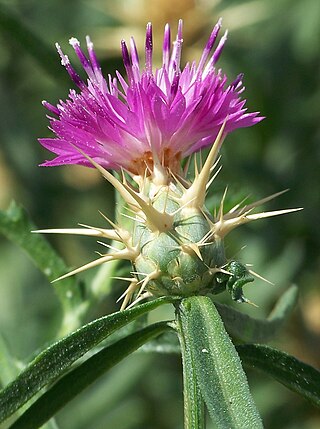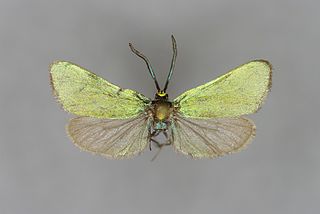
Centaurea calcitrapa is a species of flowering plant known by several common names, including red star-thistle and purple star thistle. It is native to Europe but is rarely found there, it is known across the globe as an introduced species and often a noxious weed. The species name calcitrapa comes from the word caltrop, a type of weapon covered in sharp spikes.

Theresimima is a genus of moths. T. ampellophaga, the vine bud moth, is a moth of the family Zygaenidae. It is found from Algeria, Spain and southern France through most of southern Europe to the northern coast of the Black Sea. In the north, it ranges up to Hungary and Slovakia and in the east, the range extends to the southern part of European Russia, the western Caucasus and Transcaucasia, through Turkey, Lebanon and Syria to Israel.

Konstantin Aleksandrovich Efetov is a Ukrainian biologist and biochemist, Honored Scientist of Ukraine, Academician of the Russian Academy of Natural History, Professor, Dr. Biol. Sci., Head of the Department of Biological Chemistry and Laboratory of Biotechnology of the Crimea State Medical University.

Zygaena lonicerae, the narrow-bordered five-spot burnet, is a moth of the family Zygaenidae. The species was first described by Theodor Gottlieb von Scheven in 1777.
Jordanita hispanica is a moth of the family Zygaenidae. It is found in Spain, Portugal and southern France.
Jordanita notata is a moth of the family Zygaenidae. It is found from the Iberian Peninsula and central Europe, through the northern part of the Mediterranean region to the Caucasus and Transcaucasia.
Jordanita volgensis is a moth of the family Zygaenidae. It is known from eastern Ukraine, southern Russia, Transcaucasia, Turkey and Syria.
Jordanita hector is a moth of the family Zygaenidae. It is known from southern Turkey and Lebanon.
Rhagades predotae is a moth of the family Zygaenidae. It is known from central, southern and eastern Spain.

Jordanita chloros is a moth of the family Zygaenidae.

Jordanita globulariae, also known as the scarce forester, is a day-flying moth of the family Zygaenidae.
Jordanita graeca is a moth of the family Zygaenidae. It is found from southern Slovakia through Hungary, the Balkan Peninsula, Rhodes and Cyprus to southern Russia, Ukraine, Transcaucasia, Turkey, Iran and northern Iraq.

Jordanita tenuicornis is a moth of the family Zygaenidae.
Jordanita subsolana is a moth of the family Zygaenidae. It is found from southern Spain though the southern part of central Europe, Italy, the Balkan Peninsula and Greece to southern Russia and Ukraine, Turkey and Transcaucasia up to the Altai.
Jordanita vartianae is a moth of the family Zygaenidae. It is endemic to southern and central Spain.
Adscita albanica is a moth of the family Zygaenidae. It has a disjunct distribution, which included south-eastern France, Switzerland, in Italy, Slovenia, North Macedonia, Albania, Bulgaria, Greece, Ukraine, the southern part of European Russia and the Caucasus.
Adscita krymensis is a moth of the family Zygaenidae. It is only known from the Crimea

Adscita geryon, the cistus forester, is a moth of the family Zygaenidae. It is found in southern and central Europe, east to Turkey. It is also present in Great Britain.

Metzneria ehikeella is a moth of the family Gelechiidae. It is widely distributed from central and northern Europe to the Ural Mountains. It is also present in North Africa, Turkey, the Caucasus, the Near East and Central Asia.

Camptopoeum friesei is a species of bees of the genus Camptopoeum.









